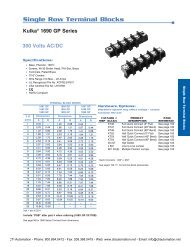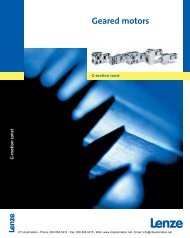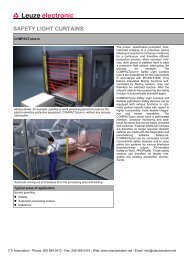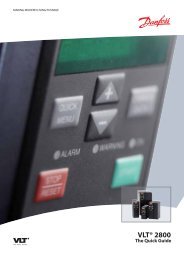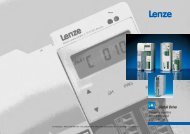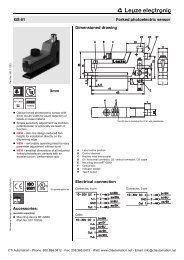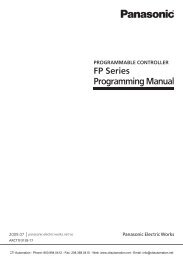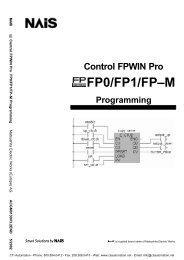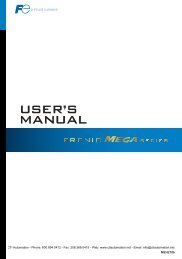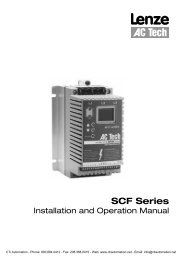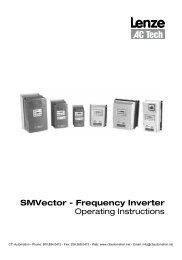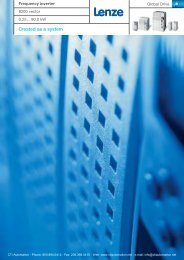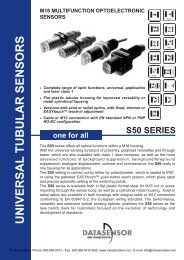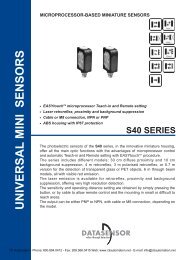FUJI FRENIC 5000P11 & 5000G11 Series Inverters - CTi Automation
FUJI FRENIC 5000P11 & 5000G11 Series Inverters - CTi Automation
FUJI FRENIC 5000P11 & 5000G11 Series Inverters - CTi Automation
Create successful ePaper yourself
Turn your PDF publications into a flip-book with our unique Google optimized e-Paper software.
Common Specifications<br />
Output<br />
frequency<br />
Control<br />
Setting<br />
Item<br />
Maximum frequency<br />
Base frequency<br />
Starting frequency<br />
Carrier frequency *1)<br />
Accuracy (Stability)<br />
Setting resolution<br />
Control method<br />
Voltage / freq. (V/f) characteristic<br />
Torque boost<br />
Operation method<br />
Frequency setting<br />
(Frequency command)<br />
Explanation<br />
G11S<br />
P11S<br />
50 to 400Hz<br />
50 to 120Hz<br />
25 to 400Hz<br />
25 to 120Hz<br />
0.1 to 60Hz, Holding time: 0.0 to 10.0s<br />
0.75 to 15kHz (75HP or smaller)<br />
0.75 to 15kHz (30HP or smaller)<br />
0.75 to 10kHz (100HP or larger)<br />
0.75 to 10kHz (40 to 100HP)<br />
0.75 to 6kHz (125HP or larger)<br />
• Analog setting : ±0.2% of Maximum frequency (at 25±10°C(77±50°F))<br />
• Digital setting : ±0.01% of Maximum frequency (at –10 to +50°C(14 to 122°F))<br />
• Analog setting : • 1/1000 of Maximum frequency ex.) 0.06Hz at 60Hz, 0.12Hz at 120Hz, (0.4Hz at 400Hz: G11S) • 1/3000 for 40HP and above<br />
• Digital setting : 0.01Hz at Maximum frequency of up to 99.99Hz (0.1Hz at Maximum frequency of 100Hz and above)<br />
• LINK setting : • 1/20000 of Maximum frequency ex.) 0.003Hz at 60Hz, 0.006Hz at 120Hz, (0.02Hz at 400Hz: G11S) • 0.01Hz (Fixed)<br />
• V/f control (Sinusoidal PWM control) • Dynamic torque-vector control (Sinusoidal PWM control) • Vector control with PG (*) (G11S only)<br />
Adjustable at base and maximum frequency, with AVR control : 320 to 480V (460V), 80 to 240V (230V)<br />
Selectable by load characteristics: Constant torque load (Auto/manual), Variable torque load (Manual)<br />
• KEYPAD operation : or key, key<br />
• Digital input signal operation : FWD or REV command, Coast-to-stop command, etc.<br />
• LINK operation : RS-485 (Standard)<br />
T-Link (<strong>FUJI</strong> private link), PROFIBUS-DP, Interbus-S, DeviceNet, Modbus Plus, JPCN1 (Option)<br />
• KEYPAD operation: or key<br />
• External potentiometer (*) : 1 to 5kΩ (1/2W)<br />
• Analog input : 0 to +10V DC (0 to +5V DC), 4 to 20mA DC<br />
(Reversible) 0 to ±10V DC (0 to ± 5V DC) ....Reversible operation by polarized signal can be selected.<br />
(Inverse) +10 to 0V DC, 20 to 4mA DC......Inverse mode operation can be selected.<br />
• UP/DOWN control : Output frequency increases when UP signal is ON, and decreases when DOWN signal is ON.<br />
• Multistep frequency : Up to 16 different frequencies can be selected by digital input signal.<br />
• Pulse train input (*) : 0 to 100kp/s<br />
• Digital signal (parallel ) (*) : 16-bit binary<br />
• LINK operation : RS-485 (Standard)<br />
T-Link (<strong>FUJI</strong> private link), RPOFIBUS-DP, Interbus-S, DeviceNet, Modbus Plus, JPCN1 (Option)<br />
Jogging operation<br />
• Programmed PATTERN operation: Max. 7 stages<br />
or key, FWD or REV digital input signal<br />
Running status signal<br />
Transistor output (4 points) : RUN, FAR, FDT, OL, LU, TL, etc.<br />
Relay output (2 points) : • Same as transistor output • Alarm output (for any fault)<br />
Analog output (1 point) : Output frequency, Output current, Output torque, etc.<br />
Pulse output (1 point) : Output frequency, Output current, Output torque, etc.<br />
Acceleration / Deceleration time 0.01 to 3600s : • Independently adjustable acceleration and deceleration • 4 different times are selectable.<br />
Mode select : Linear, S-curve (weak), S-curve (strong), Non-linear<br />
Active drive<br />
When the acceleration time reaches 60s, the motor output torque is automatically reduced to rated torque. Then the motor operation mode is changed to torque limiting operation.<br />
The acceleration time is automatically extended up to 3 times.<br />
Frequency limiter<br />
High and Low limiter can be preset.<br />
Bias frequency<br />
Bias frequency can be preset.<br />
Gain for frequency setting<br />
Gain for frequency setting can be preset. (0.0 to 200.0%) ex.) Analog input 0 to +5V DC with 200% gain results in maximum frequency at 5V DC.<br />
Jump frequency control<br />
Jump frequency (3 points) and its common jump hysteresis width (0 to 30Hz) can be preset.<br />
Rotating motor pick up (Flying start) A rotating motor (including inverse rotating mode) can be smoothly picked up without stopping the motor (speed search method).<br />
Auto-restart after momentary power Automatic restart is available without stopping motor after a momentary power failure (speed search method). When "Smooth recovery" mode is<br />
failure<br />
selected, the motor speed drop is held minimum. (The inverter searches the motor speed, and smoothly returns to setting frequency. Even if the motor<br />
circuit is temporarily opened, the inverter operates without a hitch. )<br />
Line / Inverter changeover operation Controls the switching operation between line power and inverter. The inverter has sequence function inside.<br />
Slip compensation<br />
The inverter output frequency is controlled according to the load torque to keep motor speed constant. When the value is set at<br />
"0.00" and "Torque-vector" is set at "active", the compensation value automatically selects the Fuji standard motor.<br />
Slip compensation can be preset for the second motor.<br />
Droop operation<br />
The motor speed droops in proportion to output torque (–9.9 to 0.0Hz)......G11S only.<br />
Torque limiting<br />
• When the motor torque reaches a preset limiting level, this function automatically adjusts the output frequency to prevent the inverter from tripping due to an overcurrent.<br />
• Torque limiting 1 and 2 can be individually set, and are selectable with a digital input signal.<br />
Torque control<br />
Output torque (or load factor) can be controlled with an analog input signal.....G11S only.<br />
PID control<br />
This function can control flowrate, pressure, etc. (with an analog feedback signal.)<br />
• Reference • KEYPAD operation ( or key) : Setting freq. / Max. freq. X 100 (%) • PATTERN operation : Setting freq./Max. freq. X 100 (%)<br />
signal • Voltage input (Terminal 12 ) : 0 to +10V DC • DI option input (*) : • BCD, setting freq./Max. freq. X 100 (%)<br />
• Current input (Terminal C1 ) : 4 to 20mA DC • Binary, full scale/100 (%)<br />
• Reversible operation with polarity (Terminal 12) : 0 to ±10V DC • Multistep frequency setting : Setting freq./Max. freq. X 100 (%)<br />
• Reversible operation with polarity (Terminal 12 + V1 ) : 0 to ±10V DC • RS-485 : Setting freq./Max. freq. X 100 (%)<br />
• Inverse mode operation (Terminal 12 ) : +10 to 0V DC<br />
• Inverse mode operation (Terminal C1 ) : 20 to 4mA DC<br />
• Feedback signal • Terminal 12 (0 to +10V DC or +10 to 0V DC)<br />
• Terminal C1 (4 to 20mA DC or 20 to 4mA DC)<br />
Automatic deceleration<br />
Torque limiter 1 (Braking) is set at "F41: 0" (Same as Torque limiter 2 (Braking) ).<br />
• In deceleration : The deceleration time is automatically extended up to 3 times the setting time for tripless operation even if braking resistor not used.<br />
• In constant speed operation : Based on regenerative energy, the frequency is increased and tripless operation is active.<br />
Second motor’s setting<br />
This function is used for two motors switching operation.<br />
• The second motor’s V/f characteristics (base and maximum frequency) can be preset.<br />
• The second motor’s circuit parameter can be preset. Torque-vector control can be applied to both motors.<br />
Energy saving operation<br />
This function minimizes inverter and motor losses at light load.<br />
Fan stop operation<br />
This function is used for silent operation or extending the fan's lifetime.<br />
Universal DI<br />
Transmits to main controller of LINK operation.<br />
Universal DO<br />
Outputs command signal from main controller of LINK operation.<br />
Universal AO Outputs analog signal from main controller of LINK operation.<br />
Zero speed control (*)<br />
The stopped motor holds its rotor angle.....G11S only.<br />
Positioning control (*)<br />
The SY option card can be used for positioning control by differential counter method.<br />
Synchronized operation (*)<br />
This function controls the synchronize operation between 2 axes with PGs.<br />
Note: (*) Option *1) Inverter may automatically reduce carrier frequency, in accordance with ambient temperature or output current for protecting inverter.<br />
10<br />
<strong>CTi</strong> <strong>Automation</strong> - Phone: 800.894.0412 - Fax: 208.368.0415 - Web: www.ctiautomation.net - Email: info@ctiautomation.net



